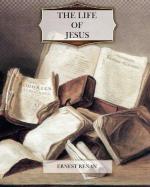[Footnote 1: Luke xxii. 20.]
[Footnote 2: 1 Cor. xi. 26.]
Very early this mystery was embodied in a small sacramental narrative, which we possess under four forms,[1] very similar to one another. John, preoccupied with the Eucharistic ideas,[2] and who relates the Last Supper with so much prolixity, connecting with it so many circumstances and discourses[3]—and who was the only one of the evangelists whose testimony on this point has the value of an eye-witness—does not mention this narrative. This is a proof that he did not regard the Eucharist as a peculiarity of the Lord’s Supper. For him the special rite of the Last Supper was the washing of feet. It is probable that in certain primitive Christian families this latter rite obtained an importance which it has since lost.[4] No doubt, Jesus, on some occasions, had practised it to give his disciples an example of brotherly humility. It was connected with the eve of his death, in consequence of the tendency to group around the Last Supper all the great moral and ritual recommendations of Jesus.
[Footnote 1: Matt. xxvi. 26-28; Mark xiv. 22-24; Luke xxii. 19-21; 1 Cor. xi. 23-25.]
[Footnote 2: Chap. vi.]
[Footnote 3: Chaps. xiii.-xvii.]
[Footnote 4: John xiii. 14, 15. Cf. Matt. xx. 26, and following; Luke xxii. 26, and following.]
A high sentiment of love, of concord, of charity, and of mutual deference, animated, moreover, the remembrances which were cherished of the last hours of Jesus.[1] It is always the unity of his Church, constituted by him or by his Spirit, which is the soul of the symbols and of the discourses which Christian tradition referred to this sacred moment: “A new commandment I give unto you,” said he, “that ye love one another; as I have loved you, that ye also love one another. By this shall all men know that ye are my disciples, if ye have love one to another. Henceforth I call you not servants; for the servant




